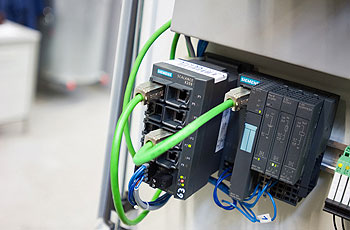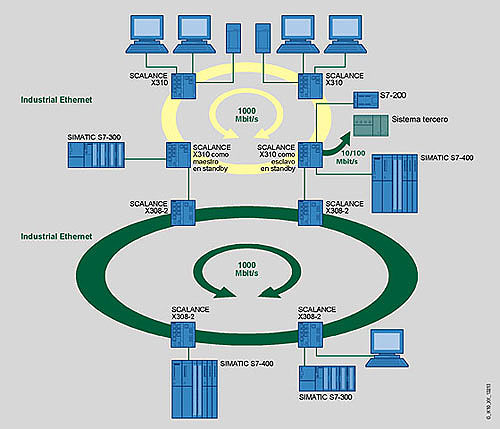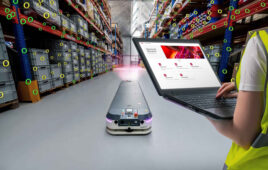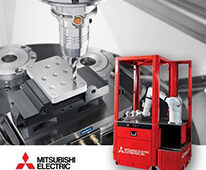Industrial Ethernet has been the source of a
great deal of discussion over the past few years. Proponents, and there
are many, seem to believe it is the shop floor equivalent of a perfect
world. Everything changes; you reduce — or even eliminate — cabling,
you get more diagnostics, more control, it’s cheaper, it’s less
proprietary.
Ethernet also has its opponents. They claim Industrial Ethernet is
too new to be trusted on the plant floor, or that it’s too expensive
when compared to field bus technology. These are just a few of the
misconceptions surrounding Industrial Ethernet.
To start
with, Ethernet is not new. The basic technology has been around for
more than 30 years and today’s industrial offerings build on that
foundation, adding key functionalities that provide the determinism,
reliability and ease-of-use required for the plant floor.

As
for the cost issue: Initial implementation costs are about the same as
field bus. You use most of the same components — PLCs, I/O, cables and
connectors — but you use an Ethernet switch instead of a field bus
node. This gives you a common infrastructure that will support most any
device you want to connect. It also makes it easier to connect to the
office network and provide senior managers with visibility and control
over the operation enhancing their ability to respond rapidly to
customer demands and leaving you with one network to maintain rather
than two or more.
That single, open infrastructure is very
important, says Jeremy Bryant, Industrial Communications manager with
Siemens Energy & Automation. “You used to get locked into a given
protocol and that would dictate some of the options you would have
regarding equipment. With Ethernet it’s not dedicated, you don’t need a
special port, just one standard cable. This leads into one of the
other major advantages, being connectivity.
“It’s a lot
like having a phone today. As long as you speak the same language you
can talk to anyone around the world. Furthermore the same phone system
can be used independent of the language.”
In the long run,
that common infrastructure will drive down your total cost of ownership
because you will no longer need specialists for each type of field bus
in use. Ethernet also allows for more effective monitoring tools,
giving you get enhanced intelligence, control and troubleshooting.
Some
proponents point to the fact that you need less cabling than with field
bus, but that isn’t really significant when compared to the other
benefits.
There’s another critical misconception, says Raj
Rajani, an Ethernet Marketing Manager with Siemens Energy &
Automation. “People think it’s too complicated; that you always have to
have IT people and IT knowledge to set up your network. That’s a
product of the fact that some IT networks are very complicated to set
up. Our industrial Ethernet networks are designed to be set up by
automation engineers. You don’t need to learn a new language.”
“The
cold fact is that because the basic network configurations are the same
your field bus expertise is highly transferable” he adds.
For
these reasons, and others, Ethernet is gradually replacing the likes of
Profibus and DeviceNet and becoming the industry standard. ARC Advisory
Group pegged the market at one million nodes in 2007 and forecasted it
would grow to more than three million by 2012.
So, having
made the decision to join the growing horde and migrate to Ethernet,
what should you do next? Siemens networking consultant Marty Jansons
has a four step approach to implementing Industrial Ethernet networks.
The first step is preplanning which, Jansons emphasizes, is the most important of the tasks.

“Look
at how many devices need to be connected to the network. And plan for
the future. What new initiatives am I going to want to implement in the
future. How many ports do I need to support growth? Do I want to lay
the groundwork for wireless? Future proof the design to some extent.”
Step
two is proof of concept. “Let’s go into the lab and make sure it all
works together. I’ve seen customers run mock ups of entire oil rigs
with simulators.” You want to make sure there won’t be any adverse
effects as you implement new technology.
“It’s not like on
the office side where the technology changes every three to five years.
On the industrial side people tend to be a lot more conservative. In
the office environment if a printer goes down you just switch to
another. In the industrial environment if a machine goes down the line
stops.”
The third step is documentation. Sooner or later
you’re going to have to troubleshoot the network and you need proper
documentation to make that possible. You need all the layouts, all the
IP addresses, blueprints and historical data.
Finally, you are ready for implementation.
“Obviously
a greenfield site is easier because you start from scratch with new
technology, but most implementations are migrations.”
Either
way Jansons recommends a phased approach, starting with installing the
infrastructure. Then you phase over part of the plant, running both
networks in parallel. Finally you gradually transfer the load
completely from the legacy network onto the new network.
Sounds easy right? Well, like anything, there are numerous pitfalls that can trip you up.
“Too
often people forget about the word ‘industrial,’” says Bryant. “The
plant floor is not the back office or home and in keeping with that
Industrial Ethernet is not the same IT and home networks typically are
installed in controlled environments.” Industrial Ethernet requires
the same ruggedization and shielding that your old field bus network
required.
“The next thing people forget about is the fact
that the person responsible for getting the network up and running is
the automation engineer,” adds Bryant. “Because we’re talking Ethernet
people think about it from an IT perspective, but at the end of the day
IT isn’t always the one troubleshooting it. Considering the demanding
uptime requirements of the plant-floor, there really isn’t time to call
in IT every time there is a glitch or a change. So you need to think
about what the automation engineer is going to need. What tools is he
familiar with? Where does he want his diagnostics data?”
Siemens
has specifically designed its Ethernet products with the automation
engineer in mind, says Rajani. “For example, with our products you can
set up devices to act like I/O devices, which makes it easier for the
automation engineer. The software package you use to set up your PLCs
configures your switches, which are set up as an I/O drop on the
network. So whatever diagnostics you desire from your switch can come
directly into the PLC. This allows existing HMI already in use to
easily display this data directly to the operator.”
“It’s not
really, ‘hook up the cable and it’s all good’,” adds Jansons. “Take a
little bit of time, think it through and design it properly. Industrial
Ethernet has a lot of advantages and you just have to give it the same
due diligence you would if you were putting in something else.”
Ethernet Timeline
• 1973: Ethernet invented at Xerox PARC
• 1980: Digital Equipment Corp., Intel and Xerox release a standard for 10M bit/sec Ethernet
• 1991: 802.3 10BaseT standards is approved, for 10M Ethernet over twisted pair telephone wire
• 1995: 802.3 100Base-T 100 M Ethernet standards is approved
• 1998: 802.3ac Gigabit Ethernet standard is approved
• 1999: 802.11b standard approved, for 11M wireless Ethernet
• 2002: 802.3ae 10G Ethernet standard is approved
• 2003: 802.11g standard approved, for 54M wireless Ethernet
• 2009: 802.11n standard expected to be approved for 600M wireless Ethernet
• 2010: 100G Ethernet expected to be approved
Industrial Ethernet Resources:
•
The Industrial Ethernet Advisory Group, a resource and community that
covers all aspects of Industrial Ethernet, including a forum for
technical support and queries, news and events, articles and product
information. www.industrialethernet.org
• An explanation of Industrial Ethernet and its various components from Siemens, a major Industrial Ethernet supplier: http://tinyurl.com/ddo93u
•
Industrial Ethernet, 2nd Edition, by Perry S. Marshall and John S.
Rinaldi, a reference tool on installation and troubleshooting of
Industrial Ethernet networks. The book is intended to help readers
“prepare to plan industrial Ethernet installations with realistic
expectations, make knowledgeable purchasing decisions, and identify and
prevent common causes of failure.”
• Industrial Ethernet on the
Plant Floor: A Planning and Installation Guide, by Robert Lounsbury,
also provides guidance on how to plan an Industrial Ethernet network,
including a discussion of network architectures, components, product
selection and the basics of noise.
::Design World::
Filed Under: Factory automation, CONNECTIVITY • fieldbuses • networks





Tell Us What You Think!